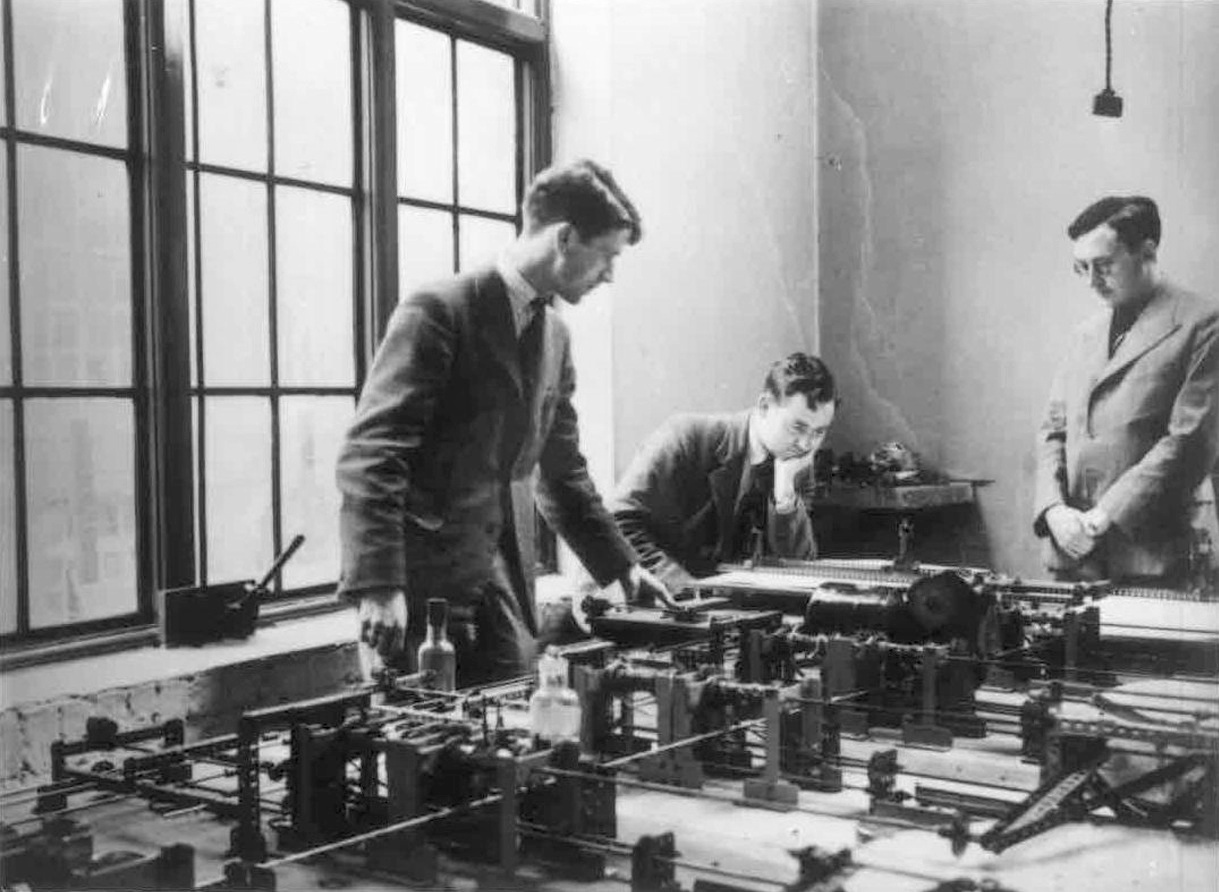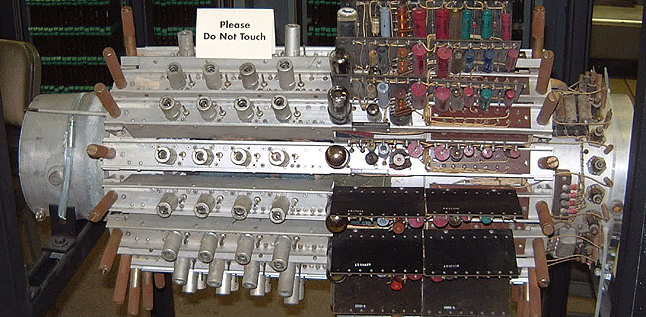|
EDSAC
The Electronic Delay Storage Automatic Calculator (EDSAC) was an early British computer. Inspired by John von Neumann's seminal ''First Draft of a Report on the EDVAC'', the machine was constructed by Maurice Wilkes and his team at the University of Cambridge Mathematical Laboratory in England to provide a service to the university. EDSAC was the second electronic digital stored-program computer, after the Manchester Mark 1, to go into regular service. Later the project was supported by J. Lyons and Co., J. Lyons & Co. Ltd., intending to develop a commercially applied computer and resulting in Lyons' development of the LEO (computer), LEO I, based on the EDSAC design. Work on EDSAC started during 1947, and it ran its first programs on 6 May 1949, when it calculated a table of square numbers and a list of prime numbers. EDSAC was finally shut down on 11 July 1958, having been superseded by EDSAC 2, which remained in use until 1965. Project and plan The concept ... [...More Info...] [...Related Items...] OR: [Wikipedia] [Google] [Baidu] |
Maurice Wilkes
Sir Maurice Vincent Wilkes (26 June 1913 – 29 November 2010) was an English computer scientist who designed and helped build the EDSAC, Electronic Delay Storage Automatic Calculator (EDSAC), one of the earliest stored-program computers, and who invented microprogramming, a method for using stored-program logic to operate the control unit of a central processing unit's circuits. At the time of his death, Wilkes was an Emeritus, Emeritus Professor at the University of Cambridge. Early life, education, and military service Wilkes was born in Dudley, Worcestershire, England the only child of Ellen (Helen), née Malone (1885–1968) and Vincent Joseph Wilkes (1887–1971), an accounts clerk at the estate of the Earl of Dudley. He grew up in Stourbridge, West Midlands, and was educated at King Edward VI College, Stourbridge. During his school years he was introduced to amateur radio by his chemistry teacher. He studied the Mathematical Tripos at St John's College, Cambr ... [...More Info...] [...Related Items...] OR: [Wikipedia] [Google] [Baidu] |
EDSAC 2
EDSAC 2 was an early vacuum tube computer (operational in 1958), the successor to the Electronic Delay Storage Automatic Calculator (EDSAC). It was the first computer to have a microprogrammed control unit and a bit-slice hardware architecture. First calculations were performed on the incomplete machine in 1957. Calculations about elliptic curves performed on EDSAC-2 in the early 1960s led to the Birch and Swinnerton-Dyer conjecture, a Millennium Prize Problem, unsolved as of 2024. And in 1963, Frederick Vine and Drummond Matthews used EDSAC 2 to generate a magnetic anomaly map of the seafloor from data collected in the Indian Ocean by H.M.S. Owen, key evidence that helped support the theory of plate tectonics. EDSAC-2 was decommissioned in 1965, having been superseded by the Titan computer Titan most often refers to: * Titan (moon), the largest moon of Saturn * Titans, a race of deities in Greek mythology Titan or Titans may also refer to: Arts and entertainment Fictiona ... [...More Info...] [...Related Items...] OR: [Wikipedia] [Google] [Baidu] |
EDSAC 2
EDSAC 2 was an early vacuum tube computer (operational in 1958), the successor to the Electronic Delay Storage Automatic Calculator (EDSAC). It was the first computer to have a microcode, microprogrammed control unit and a bit-slice hardware architecture. First calculations were performed on the incomplete machine in 1957. Calculations about elliptic curves performed on EDSAC-2 in the early 1960s led to the Birch and Swinnerton-Dyer conjecture, a Millennium Prize Problem, unsolved as of 2024. And in 1963, Frederick Vine and Drummond Matthews used EDSAC 2 to generate a magnetic anomaly map of the seafloor from data collected in the Indian Ocean by HMS Owen (K640), H.M.S. Owen, key evidence that helped support the theory of plate tectonics. EDSAC-2 was decommissioned in 1965, having been superseded by the Titan (1963 computer), Titan computer. References External links * 1950s computers 1958 establishments in England 1958 in computing Computer-related introductions in 195 ... [...More Info...] [...Related Items...] OR: [Wikipedia] [Google] [Baidu] |
University Of Cambridge Mathematical Laboratory
The Department of Computer Science and Technology, formerly the Computer Laboratory, is the computer science department of the University of Cambridge. it employed 56 faculty members, 45 support staff, 105 research staff, and about 205 research students. The current Head of Department is Professor Alastair Beresford. History The department was founded as the Mathematical Laboratory under the leadership of John Lennard-Jones on 14 May 1937, though it did not get properly established until after World War II. The new laboratory was housed in the North Wing of the former Anatomy School, on the New Museums Site. Upon its foundation, it was intended "to provide a computing service for general use, and to be a centre for the development of computational techniques in the University". The Cambridge Diploma in Computer Science was the world's first postgraduate taught course in computing, starting in 1953. In October 1946, work began under Maurice Wilkes on EDSAC (''Electronic D ... [...More Info...] [...Related Items...] OR: [Wikipedia] [Google] [Baidu] |
LEO (computer)
The LEO (Lyons Electronic Office) was a series of early computer systems created by J. Lyons and Co. The first in the series, the LEO I, was the first computer used for commercial business applications. The prototype LEO I was modelled closely on the University of Cambridge, Cambridge EDSAC. Its construction was overseen by Oliver Standingford, Raymond Thompson and David Caminer of J. Lyons and Co. LEO I ran its first business application in 1951. In 1954 Lyons formed LEO Computers Ltd to market LEO I and its successors LEO II and LEO III to other companies. LEO Computers eventually became part of English Electric Company (EEL), (EELM), then English Electric Computers (EEC), where the same team developed the faster LEO 360 and even faster LEO 326 models. It then passed to International Computers Limited (ICL) and ultimately Fujitsu. LEO series computers were still in use until 1981. Origins and initial design J. Lyons and Co. was one of the UK's lead ... [...More Info...] [...Related Items...] OR: [Wikipedia] [Google] [Baidu] |
Delay-line Memory
Delay-line memory is a form of computer memory, mostly obsolete, that was used on some of the earliest Digital data, digital computers, and is reappearing in the form of #Optical_delay_lines, optical delay lines. Like many modern forms of electronic computer memory, delay-line memory was a memory refresh, refreshable memory, but as opposed to modern random-access memory, delay-line memory was Sequential access, sequential-access. Analog delay line technology had been used since the 1920s to delay the propagation of analog signals. When a delay line is used as a memory device, an amplifier and a pulse shaping, pulse shaper are connected between the output of the delay line and the input. These devices recirculate the signals from the output back into the input, creating a loop that maintains the signal as long as power is applied. The shaper ensures the pulses remain well-formed, removing any degradation due to losses in the medium. The memory capacity equals the time to transmit ... [...More Info...] [...Related Items...] OR: [Wikipedia] [Google] [Baidu] |
Manchester Baby
The Manchester Baby, also called the Small-Scale Experimental Machine (SSEM), was the first electronic stored-program computer. It was built at the University of Manchester by Frederic Calland Williams, Frederic C. Williams, Tom Kilburn, and Geoff Tootill, and ran its first program on 21 June 1948. The Baby was not intended to be a practical computing engine, but was instead designed as a testbed for the Williams tube, the first truly random-access memory. Described as "small and primitive" 50 years after its creation, it was the first working machine to contain all the elements essential to a modern electronic digital computer. As soon as the Baby had demonstrated the feasibility of its design, a project was initiated at the university to develop it into a full-scale operational machine, the . The Mark 1 in turn quickly became the prototype for the Ferranti Mark 1, the world's first commercially available general-purpose computer. The Baby had a 32-bit Word (computer architect ... [...More Info...] [...Related Items...] OR: [Wikipedia] [Google] [Baidu] |
Von Neumann Architecture
The von Neumann architecture—also known as the von Neumann model or Princeton architecture—is a computer architecture based on the '' First Draft of a Report on the EDVAC'', written by John von Neumann in 1945, describing designs discussed with John Mauchly and J. Presper Eckert at the University of Pennsylvania's Moore School of Electrical Engineering. The document describes a design architecture for an electronic digital computer made of "organs" that were later understood to have these components: * A processing unit with both an arithmetic logic unit and processor registers * A control unit that includes an instruction register and a program counter * Memory that stores data and instructions * External mass storage * Input and output mechanisms.. The attribution of the invention of the architecture to von Neumann is controversial, not least because Eckert and Mauchly had done a lot of the required design work and claim to have had the idea for stored programs ... [...More Info...] [...Related Items...] OR: [Wikipedia] [Google] [Baidu] |
Stored-program Computer
A stored-program computer is a computer that stores program instructions in electronically, electromagnetically, or optically accessible memory. This contrasts with systems that stored the program instructions with plugboards or similar mechanisms. The definition is often extended with the requirement that the treatment of programs and data in memory be interchangeable or uniform. Description In principle, stored-program computers have been designed with various architectural characteristics. A computer with a von Neumann architecture stores program data and instruction data in the same memory, while a computer with a Harvard architecture has separate memories for storing program and data. However, the term ''stored-program computer'' is sometimes used as a synonym for the von Neumann architecture. Jack Copeland considers that it is "historically inappropriate, to refer to electronic stored-program digital computers as 'von Neumann machines. Hennessy and Patterson wrote th ... [...More Info...] [...Related Items...] OR: [Wikipedia] [Google] [Baidu] |



